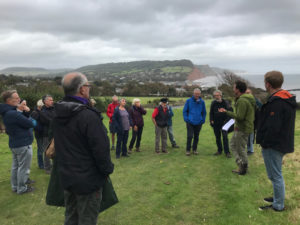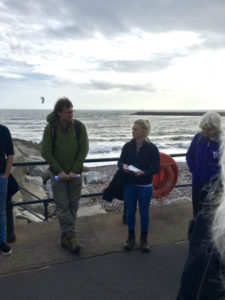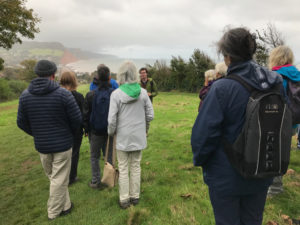By Daneen Cowling and Tom Powell

A week in advance of Earth Science week, Devon saw the arrival of the annual celebration for science in the seaside town of Sidmouth. The event hosts various engagement and educational activities across the spectrum of science, utilising the Sidmouth landscape as creative learning spaces. The Sidmouth Science Festival ran between 4th-13th October 2019.
This year scientists from the Global Systems Institute at the University of Exeter had the opportunity to lead a Deep Time Walk through the wooded paths across Sidmouth’s red cliffs. Dr Tom Powell, who specialises in how humanity interacts with the Earth system and Research Masters student Daneen Cowling specialising in deep time coastal carbonate weathering, together led a bespoke Sidmouth Deep Time Walk. Content was inspired by experiences on Deep Time Walks led by Dr Stephan Harding, and interactive storytelling on the Deep Time Walk App. Tom and Daneen were also able to inject their own knowledge into the conversations along the walk, as well as incorporating Sidmouth and Devon natural history to the walk.
Science was not the only input, creativity and engagement with science and the natural environment was also culminated from consultations with Anne-Marie Culhane. Using her experiences from her own innovations for Earth Walking and other events, we were able to cultivate an immersive activity educational and engaging.
Walking Deep Time
Meeting outside the Sidmouth Museum, we were greeted by a large group of enthusiastic walkers. Introducing the GSI and ourselves, we then explained the creative and scientific thought journey behind the walk story and route. Setting off towards the cliff we paused moments later to discuss the formation of the solar system. Starting from the absolute beginning, 4.5 billion years ago. Pushing on towards the coast we immersed in the chaotic birth and building of the foundation of our planet and its orbiting moon.

We then transgress the molten rock world to a chemically interesting and active planet. One by which the environment controls how life can soon arrive, adapt and evolve. As we gained elevation we also gained in the exciting stories and revolutions that Earth has witnessed through its history. From the arrival of life, the creation and crusting Earth surface, and the many episodes of climate extremes such as the several episodes of Snowball Earth – an ice enclosed Earth onset by runaway feedbacks, escaped by CO2 buildup from volcanism.
Further into the woodland trails, sheltered by the wealth of vegetation blanketing the floor and sheltering us from the encroaching rain, we entered the geological periods controlled by the rapid evolutions and diversifications of life on Earth. Exploring the extensive arrivals of new species in the seas, soils and skies as we walked, punctuated by shorter walks with no stories as we symbolise the scale of rapidity these changes took force. Reaching the Triassic period we were conveniently paused on top of High Peak cliff overlooking the red desert sandstones, aiding the visualisation of how the landscape would have looked at the time, as well as the different dominant species.
Descending back to the coast we whizzed through the relatively rapid geological periods that followed the Triassic, soon to arrive at the Holocene and the arrival of man. To contribute to the understanding of speed at which humans took the reins of planetary-scale environmental influence, we gave out Deep Time Line that represent human history (20,000 years) along the scale of a 10cm ruler. From the first evidence left by humans, it was not long until we were in the thick of the industrial revolution. From species extinction, global chemistry changes, ecosystem reductions and management to the uncontrolled emittance of CO2 triggering a human-made climate change acceleration, in such a short period of Earths history we have had geological scale influence, so much so we’ve created our own epoch; The Anthropocene.
Returning back to the coast we paused to panoramically view the landscape ahead of us; rolling hills with geometric hedges and patches of woodland, punctuated by clusters of houses. With this view we asked the group to spot an area that has not, in some way, been influenced by humans. Unsurprisingly, we came to the realisation we were looking at a very “unnatural natural” landscape. Shrinking down from the global scale of humans on the environment, it was clear to even be evident locally, which raises one of the many questions: Is anything natural anymore? Land management right down to the species of trees we want to grow for timber has varying impacts, in some cases able to introduce new species and ecosystems, but at the expense of the previous and the species that once thrived.

To finish the walk, Tom demonstrated a ‘complex systems’ game introduced to us by Robin de Carteret. With all members of the group standing in a circle, we impose one simple rule; each person has to choose two other members of the group and remain equidistant to them at all times. This produces chaos as everyone moves to positions themselves with respect to their two chosen people, but gradually settles down as a stable arrangement emerges from the system. This brilliantly demonstrates the kinds of dynamic systems we study, in which stability can emerge as a result of dynamic interactions. We used the idea to demonstrate some of the characteristics of the Earth system by assigning a role to each member (e.g. rainforests, CO2, ice), and experimented with what happened when one or more parts of the system was perturbed by asking the people representing CO2 and rainforests to move slightly. At first this caused small ripples through the system, causing everyone to slightly adjust their position before stability was found again, but with a larger perturbation chaos ensued again, and the whole system broke down before eventually finding a new stable state. Finding this state does not happen on the same timescales for each “experiment”, as this depends on the resilience of the system and its efficiency to bounce back from perturbation, which captured the sensitivity scientists must account for in models.
The Sidmouth Science Festival was another success for engagement and educating, definitely with added enjoyment while doing so! Sidmouth will also be hosting a Clean Growth Event next February with more collaboration with the University of Exeter, so keep your eyes peeled.
To learn more about engagement and outreach opportunities with the University of Exeter Global Systems Institute, please contact:
Tom Powell t.powell@exeter.ac.uk | Daneen Cowling dc456@exeter.ac.uk
To find out more about the organisations mentioned, please follow the links below:
Anne-Marie Culhane: Creative environmental and art projects
Stephan Harding: Deep Time Walk
Robin de Carteret: Interactive activities to connect with the natural world
